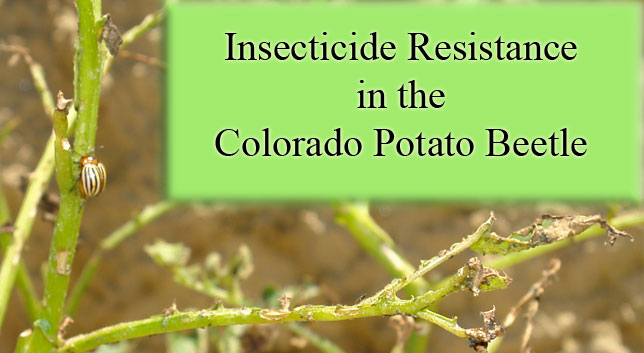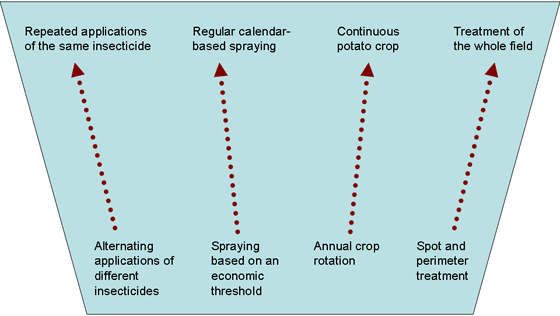

The Problem
Pesticide resistance in arthropods is a serious problem that costs farmers millions, if not billions, of dollars each year. Currently, more than 500 different species of arthropods are resistant to a wide variety of chemicals (http://whalonlab.msu.edu/database.html). Cases of resistance have been reported from 168 countries, making it a truly global phenomenon. Some pests are resistant to a single compound; however, many of them are simultaneously resistant to several related, or even unrelated chemicals. New cases of resistance are being continuously detected in a wide variety of crops, and no commercial grower can consider himself (or herself) to be completely immune from this problem.
Process of Resistance Development
Development of insecticide resistance in insect populations is a typical evolutionary process driven by survival of the fittest individuals. Initially, resistant insects result from random mutations caused by some internal (e.g., various molecules bumping against DNA in their chromosomes) or external (e.g., solar radiation) factors. As is usually the case for most oddball individuals, resistant mutants do not do very well among the general population under normal conditions. Their survivorship and reproductive success is usually lower than that of their susceptible peers. Therefore, relatively few of them persist in a population that is not exposed to a particular insecticide to which they have developed resistance.
The situation changes dramatically when such an insecticide is being applied. Resistant insects find themselves in a position of a class nerd who made a fortune in computer business and flies his private jet to a high school reunion. The chemical is killing off susceptible genotypes, while resistant mutants survive and thrive in the absence of competition. Pretty soon, their numbers increase to the densities sufficient for causing economically significant damage.
Below is the schematic diagram outlining the process of resistance development (Fig. 2.1):

Most commonly, insects become resistant to a single chemical to which they were exposed. However, in some cases selection by one pesticide results in resistance to one or more other pesticides. Usually (but not always) these pesticides have similar chemistry and mode of action. This phenomenon is known as cross-resistance. In other cases, simultaneous and/or successive selection by several different pesticides may result in resistance to all of them. This phenomenon is known as multiple resistance.
Mechanisms
A number of different mechanisms within the insect may be involved to produce resistance. Detoxification in resistant organisms may increase compared to susceptible organisms because a pesticide molecule is changed once it enters the organism to become non-toxic. This could be achieved by producing more enzymes, or by changing enzyme structure and function to make them better in deactivating the poisons. In other cases, a pesticide molecule remains intact, but the resistant organism changes to minimize its deleterious effects. This may involve changes in cellular structures targeted by pesticides to decrease their vulnerability, increased rates of excretion of toxic molecules, their sequestration and storage inside of the insect body away from vulnerable tissues and organs, and decreased toxin penetration through the insect body wall. In still other cases, pests may change their behavior to avoid exposure to pesticides. Sometimes, more than one resistance mechanisms may exist in the same population (or even within the same individual).
Often, mutation in a single gene only leads to the development of a resistant organism. Resistant genes are usually autosomal. This means that they are located on autosomes (as opposed to sex chromosomes). As a result, resistance is inherited similarly in males and females. Also, resistance is usually inherited as an incompletely dominant trait. When a resistant and a susceptible individual mate with each other, their progeny has an intermediate level of resistance (more resistant than the susceptible parent, but not as resistant as the resistant parent). As already mentioned above, having resistant genes usually decreases relative fitness of organisms. Resistant individuals often have reduced reproductive output, life expectancy, mobility, etc.
Who is at risk
The first step in a resistance management program is identifying fields where the Colorado potato beetles are at high risk of developing resistance. In theory, any field that has been treated with any insecticides is at risk. However, on some fields the risk is higher than on the others. Generally speaking, the more extensively a given chemical is used -- the higher the probability becomes that it will fail due to resistance development (Fig. 1.2). Therefore, relying on a single insecticide as a sole method of keeping the beetle populations in check will eventually result in failure, while integrating various chemical and non-chemical techniques will keep beetle populations under damaging levels for greater periods of time.
High Risk

Low Risk
Fig. 2.2. Risk of insecticide resistance as a function of management practices.
For an in-depth scientific review of insecticide resistance in the Colorado potato beetle, please refer to
Alyokhin, A., M. Baker, D. Mota-Sanchez, G. Dively, and E. Grafius. 2008. Colorado potato beetle resistance to insecticides. American Journal of Potato Research 85: 395–413.
Click here to read full text of the article free of charge.